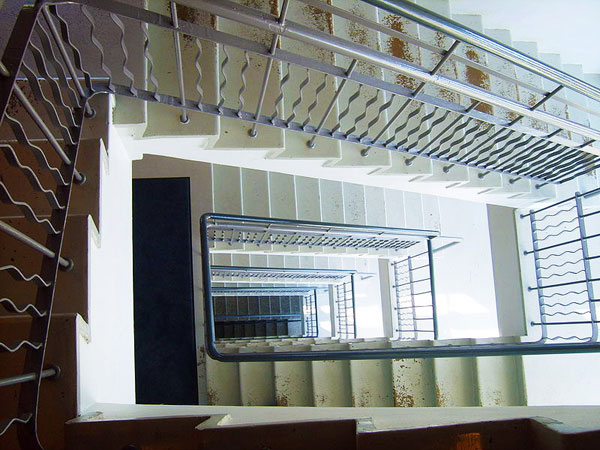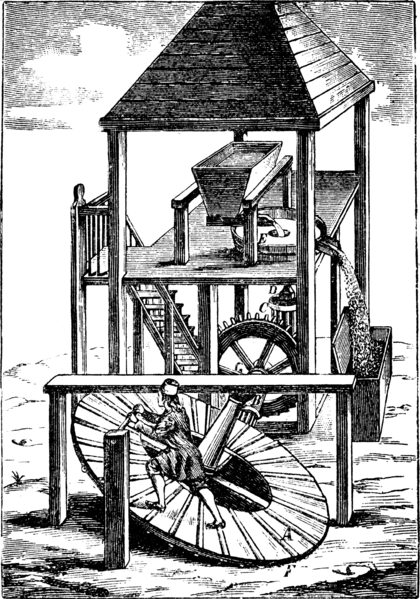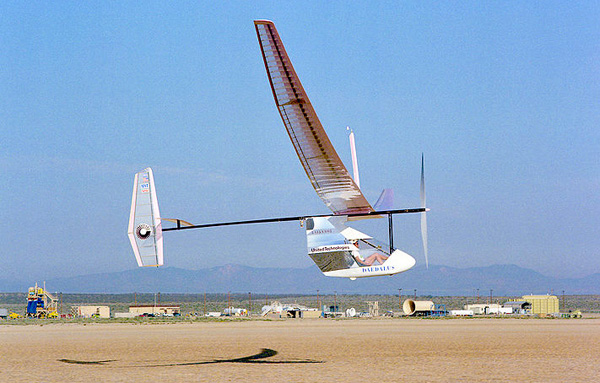Blake levies the odd claim that "Energy is the only life and is from the body." Really? After all, so much energy reach us from outside our bodies. Still, if we're to understand energy we need to see how it arises in our own body and our own senses.
So I ask, "How powerful am I in comparison with all those many engines that serve my every whim?" Here's an experiment which addresses that question — an experiment that all of us should take the trouble of doing: Let's run up several flights of stairs as fast as we can, using a watch to measure how long it takes.
Suppose we climb 3 flights in 20 seconds. Now multiply the height we climb by our weight. If we weigh 150 pounds and climb 40 feet, then we've done 6,000 foot-pounds of work in 20 seconds. That's 300 foot-pounds per second. A horsepower is 550 foot-pounds a second, so our hypothetical self has generated just over half a horsepower. Do that with your own body. Actually take the trouble to run the stairs. Feel the energy flowing through you.
Someone in good shape can generate a whole horsepower in that short burst. But if we climb all day we obviously have to slow down. Can we climb a 6,000-foot mountain in 8 hours? That's only about 30 foot-pounds a second — about a 20th of a horsepower.

Looks tiring, No? [Image courtesy of Wikimedia Commons]
This gets interesting when we compare our power output with the machines that serve us. Suppose human beings had to power the generator that supplied a 150-watt light bulb. It would take 15 people doing five-man, eight-hour shifts to keep that light burning.
An automobile engine that generates 100 horsepower does the work of 2,000 people. But when those people have to rest at the end of eight hours, the automobile keeps right on going. If everyone in America worked like galley slaves, they'd generate barely enough electricity to power a small city.
The engines of our ingenuity are big and powerful. We're absolutely dependent on huge supplies of power. Yet we're puny beside those machines. The very magnitude of our power plants casts a shadow over our well-being. If they burn fossil fuel, they affect the air around us. If they use nuclear fuel, we can't agree on what to do with their waste. Solar energy, in any form, eats up vast amounts of real estate. Our massive use of manufactured energy always comes at a cost.

This fanciful sketch from a Renaissance book of "new machines" shows a man powering a gristmill. In fact such mills would have required around 50 times the power he could have produced.
So try my experiment — time yourself running the stairs. Feel the astonishing difference in scale we've created between our machines and ourselves. We're like mice directing the movements of elephants. In the end, our only protection from those great beasts is restraint — restraint in the use of energy, restraint in our wants. Run up the stairs and measure your power output. Take a long close look at the enormous gulf between us and our machines.

The 70-lb, human-powered Daedalus with the wingspan of a Boeing 747. Greek cyclist Kanellos Kanellopoulos flew it 74 miles from Crete to Santorini in four hours sustaining 1/4 HP. [Image courtesy NASA]
We learn more from this exercise than just the need to view those machines with a well-balanced mixture of fear and respect. It's also a way to understand just what Blake meant when he reminded us that the Energy is the only life and is from the Body. For we are the ultimate and only yardstick against which all energy production must be measured.
Elaboration:
A horsepower is defined at work done at a rate of 550 ft-lb/second. Applying that to our exercise of running upstairs, we get:
Our horsepower = (our weight in lbs.) times (the height in feet we lift ourselves) divided by (550) times (the time in seconds that it takes us)
Power in kilowatts = (0.746) x (power in Horsepower)
| Power Supply | Power Output (HP) |
| A laborer working all day | 0.05 |
| Cyclist who spent 4 hours flying the human-powered airplane, Daedalus, 74 miles | 0.25 |
| A farm horse working all day | 0.30 |
| Medieval waterwheel | 3 |
| A medieval wind mill | 5 |
| Early 18th-century steam engine | 12 |
| Largest modern steam power plants | 3,500,000 |
Sources
See also the Wikipedia articles on Horsepower http://en.wikipedia.org/wiki/Horsepower and on human-powered aircraft http://en.wikipedia.org/wiki/Human-powered_aircraft.